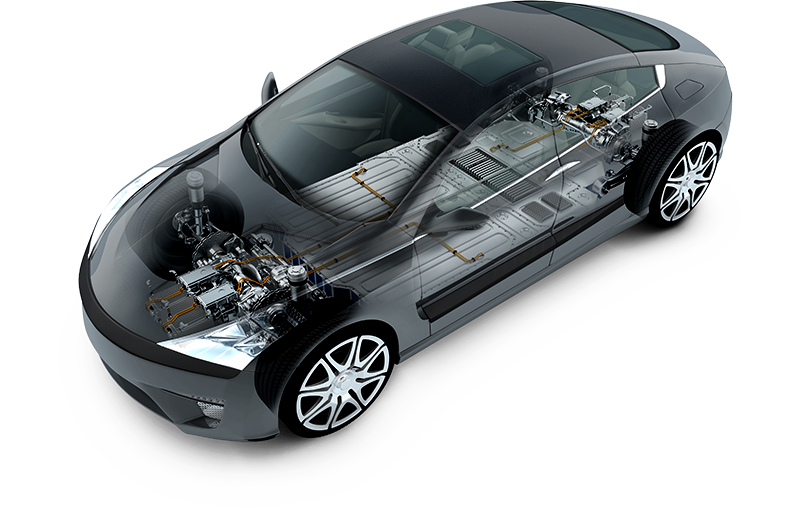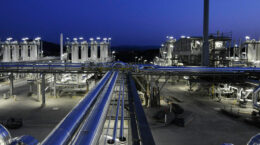
Explore the car to learn more about how e-mobility works.
Charging Systems
Charging systems have to withstand the stresses of running a lot of electricity, often in a short period of time. And increasingly, they have to withstand the rigors of outdoor, public life exposure to the elements, vandals and the occasional bump from a car.
Housings
BASF enables designers to create housings that are stylish and light weight while allowing for a high degree of functional integration. Ultramid® high-strength, polyamide engineering plastics offer improved durability with greater design freedom than steel and aluminum. Elastopor® polyurethane foam systems improve strength and durability of housing components.
Connectors
Connectors have to withstand daily use that could involve the impact of being repeatedly dropped or run over by a vehicle. BASF's Ultramid® PA and Ultradur® PBT engineering thermoplastics have the strength, toughness and electrical properties to meet or exceed these demanding requirements.
Cable Sheaths
Elastollan® thermoplastic polyurethane (TPU) is used in a variety of wire and cable applications and it is an excellent choice for the jacketing of charging cables. The outstanding abrasion resistance and excellent flexibility at low temperatures make Elastollan® an ideal material for cable jacketing and insulation.
Battery Cells
What is the heart of the e-mobility? The battery. And at the heart of the battery is the cell. Its performance is fundamental to the success of e-mobility.
Anode
The anode, also known as the negative electrode, is made of graphite, a natural form of carbon with a layered structure. While charging the battery, the lithium-ions are incorporated into the anode.
Cathode Active Materials
The cathode, also known as the positive electrode, consists of a mixed-metal oxide containing lithium. While charging the battery, the lithium-ions move out of the crystal structure of the cathode and travel to the anode. High performance cathode active materials provide a higher energy density, which enables longer driving distance by combining a high degree of purity, unique morphology and excellent electrochemical properties.
Electrolytes
Electrolytes allow the lithium-ions carrying the battery’s charge to flow freely between the cathode and the anode. Electrolytes must be extremely pure and as free of water as possible in order to ensure efficient charging and discharging of the battery.
Battery Packs
Safely and efficiently assembling the cells, modules and pack is an engineering challenge. These wide range of materials and technologies can be used to reduce mass, enhance design flexibility and allow for component and function integration.
Casings
Battery packs are designed to last for more than 10 years, so the battery cases need to withstand extreme environmental conditions and be durable for the long term. Our technologies and concepts for battery packs build on our long history of success converting the metal structures to reinforced thermoplastics. Cases constructed with engineering plastics can achieve up to a 40% mass reduction, while reducing cost through functional integration and tooling savings.
Cell Frames
Batteries often use cell frame supports when they are assembled into modules. Our high-strength, temperature-resistant Ultramid® thermoplastics are designed to be both lightweight and strong, enhancing durability and battery life expectancy. Depending on customer requirements, we also offer grades with superior hydrolytic stability, flame retardance and dimensional stability.
Charging Systems
Charging systems have to withstand the stresses of running a lot of electricity, often in a short period of time. And increasingly, they have to withstand the rigors of outdoor, public life exposure to the elements, vandals and the occasional bump from a car.
Housings
BASF enables designers to create housings that are stylish and light weight while allowing for a high degree of functional integration. Ultramid® high-strength, polyamide engineering plastics offer improved durability with greater design freedom than steel and aluminum. Elastopor® polyurethane foam systems improve strength and durability of housing components.
Connectors
Connectors have to withstand daily use that could involve the impact of being repeatedly dropped or run over by a vehicle. BASF's Ultramid® PA and Ultradur® PBT engineering thermoplastics have the strength, toughness and electrical properties to meet or exceed these demanding requirements.
Cable Sheaths
Elastollan® thermoplastic polyurethane (TPU) is used in a variety of wire and cable applications and it is an excellent choice for the jacketing of charging cables. The outstanding abrasion resistance and excellent flexibility at low temperatures make Elastollan® an ideal material for cable jacketing and insulation.
Battery Cells
What is the heart of the e-mobility? The battery. And at the heart of the battery is the cell. Its performance is fundamental to the success of e-mobility.
Anode
The anode, also known as the negative electrode, is made of graphite, a natural form of carbon with a layered structure. While charging the battery, the lithium-ions are incorporated into the anode.
Cathode Active Materials
The cathode, also known as the positive electrode, consists of a mixed-metal oxide containing lithium. While charging the battery, the lithium-ions move out of the crystal structure of the cathode and travel to the anode. High performance cathode active materials provide a higher energy density, which enables longer driving distance by combining a high degree of purity, unique morphology and excellent electrochemical properties.
Electrolytes
Electrolytes allow the lithium-ions carrying the battery’s charge to flow freely between the cathode and the anode. Electrolytes must be extremely pure and as free of water as possible in order to ensure efficient charging and discharging of the battery.
Battery Packs
Safely and efficiently assembling the cells, modules and pack is an engineering challenge. These wide range of materials and technologies can be used to reduce mass, enhance design flexibility and allow for component and function integration.
Casings
Battery packs are designed to last for more than 10 years, so the battery cases need to withstand extreme environmental conditions and be durable for the long term. Our technologies and concepts for battery packs build on our long history of success converting the metal structures to reinforced thermoplastics. Cases constructed with engineering plastics can achieve up to a 40% mass reduction, while reducing cost through functional integration and tooling savings.
Cell Frames
Batteries often use cell frame supports when they are assembled into modules. Our high-strength, temperature-resistant Ultramid® thermoplastics are designed to be both lightweight and strong, enhancing durability and battery life expectancy. Depending on customer requirements, we also offer grades with superior hydrolytic stability, flame retardance and dimensional stability.


